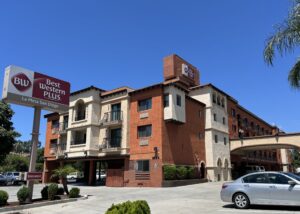Climate tough for building, buying hotels
Climate tough for building, buying hotels
Thursday, August 17, 2023
By Thor Kamban Biberman
High interest rates are scuttling many hotel sales, other hotel owners don’t want to sell, and finding financing for new hotels is extremely challenging, according to the latest report from Atlas Hospitality Group.
San Diego County’s individual sales decreased 48 percent year-over-year in the first half of 2023, and its total dollar volume dropped 45 percent.
There was at least one notable transaction in the county during the first half of the year, however. The Chesapeake Hotel Group REIT and Greenfield Partners, a real estate investment fund, acquired the 133-room Pala Mesa Resort in Fallbrook for $53 million in May.
The median price per room for San Diego’s hotels increased 52 percent year-over-year to $230,040 while all the other numbers declined.
The county posted 13 hotel sales during the first half of the year, which was about half the number of hotel sales completed during the first six months of 2022, according to Atlas
The overall sales volume through mid-year was $200.36 million, compared with $362.54 million during the first half of 2022.
In terms of room count, the overall volume in San Diego dropped 51.6 percent year-over-year to just 1,013 during the first six months of 2023.
“California individual hotel sales during the first half of the year were down 53 percent from the like period in 2022,” Atlas reported. “The only other year we have seen such a significant decline was in the first half of 2009, when individual sales were down 51 percent. California has seen eight hotels foreclosed on in the first half of 2023 — the largest of which was the 394-room Fairmont Century Plaza Hotel (in Los Angeles).”
Atlas Hospitality Group president Alan Reay acknowledged that high interest rates absolutely clobbered hotel sales during the first half of the year.
He said this was the worst year for hotel sales since at least 2009 during the Great Recession.
As challenging as it is in San Diego, Reay said it is much worse in the Bay Area, where Park Hotels has been trying to return a pair of San Francisco hotels to their lenders. The hotels, the 1,024-room Parc 55 and the 1,921-room Hilton Union Square, have more than $1 billion in debt combined.
Reay said San Diego hotels tend to be in much better fiscal shape than the Bay Area for a variety of reasons. One is because San Diego is less dependent on the tech economy that is so prevalent in the northern part of the state.
“San Diego has very diverse industries,” he said, adding that another issue is that the homeless problem. Although it is a problem here, it is less pronounced than it is in a city such as San Francisco or San Jose.
“San Diego is also picking up conventions that might previously have gone to San Francisco or San Jose,” Reay said.
While some big convention hotels have been having their problems in the northern part of the state, Reay said he expects the Gaylord Hotel in Chula Vista, which will have nearly 500,000 square feet of convention and event space, to fare very well.
“Gaylord will be more of a destination, rather than only being a convention hotel,” he said.
As far as new hotels go that haven’t started construction, Reay said financing may be impossible.
“Financing isn’t getting any easier,” he said, adding that not only has the cost of money soared with the interest rates, borrowers have had to put significantly more down than they have in the past — that is if they can get a loan at all. Then there is the other basic problem.
“Hotel owners don’t want to sell,” Reay said.
Some hotel properties, particularly budget hotels, are being converted to other uses, such as housing or, more recently, into homeless shelters, further causing the inventory to dwindle.
Budget motels, or motor courts, may have transformed the landscape in the middle of the last century, but with high land, labor, insurance and carrying costs, Reay said new ones aren’t being built.
“You can’t afford to build a budget brand these days,” he said.


